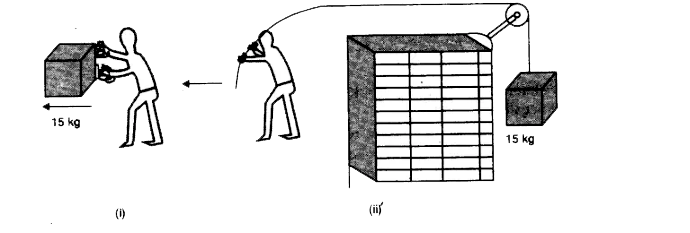Statement - A : Heat energy required for burning a case of rocket in flight is obtained from the rocket itself and not from the atmosphere
Statement - B : work done by the gravitational force (conservative force) of the sun over a closed path in every complete highly elliptical orbit of the comet is zero
Both A and B are false
Both A and B are true
A is true but B is false
A is false but B is true
The correct Answer is:B
Topper's Solved these Questions
- WORK POWER ENERGYBook:AAKASH SERIESChapter:WORK POWER ENERGYExercise:EXERCISE - 1B
Explore 39 Videos
- WORK POWER ENERGYBook:AAKASH SERIESChapter:WORK POWER ENERGYExercise:EXERCISE - 2
Explore 107 Videos
- WORK POWER ENERGYBook:AAKASH SERIESChapter:WORK POWER ENERGYExercise:EXERCISE - 3
Explore 61 Videos
- WORK -POWER-ENERGYBook:AAKASH SERIESChapter:WORK -POWER-ENERGYExercise:PRACTICE SHEET (ADVANCED) (STRAIGHT OBJECTIVE TYPE QUESTIONS)
Explore 36 Videos
- WORK, POWER & ENERGY Book:AAKASH SERIESChapter:WORK, POWER & ENERGY Exercise:PRACTICE EXERCISE (PERFECTLY INELASTIC COLLISIONS)
Explore 5 Videos
Similar Questions
Statement-1:When a planet approches the point which is farthest from the sun, its orbital speed decreases.
Statement-2: Work done on the planet by the gravitational force exerted by the sun is negative.
View SolutionAnswer the following:
a) The casing of a rocket in flight burns up due to friction. At whose expense is the heat required for burning obtained? The rocket or the atmosphere?
b) Comets move around the sun in highly elliptical orbits. The gravitational force on the comet due to the sun is not normal to the comet's velocity in general. Yet the work done by the gravitatonal force over every complete orbit of the comet is zero. Why?
c) An artificial satellite orbiting the earth in very atmosphere loses its energy grdually due to dissipation against atmospheric resistance, howerver small. Why then does its speed increase progressively as it comes closer and closer tothe earth? d)In fig i) the man walks 2m carrying a mass of 15 kg on his hands. In Fig ii) he walks the same distance pulling the rope behind him. The rope goes over pulley, and a mass of 15 kg hangs at its other end. In which case is the work done greater?

View Solution
Knowledge Check
Statement-1:When a planet approches the point which is farthest from the sun, its orbital speed decreases.
Statement-2: Work done on the planet by the gravitational force exerted by the sun is negative.AStatement-1 is true, statement-2 is true, Statement-2 is a correct explanation for statement-1.BStatement-1 is true, Statement-2 is true, statement-2 is Not a correct explanation for statement-1CStatement-1 is true, Statement-2 is false.DStatement-1 is false Statement-2 is True.Statement-1:Comets move around the sun in elliptical orbits, the gravitational force on the comet due to sun is not normal to the comet's velocity, but the work done by the gravitational force over every complete orbit of the comet is zero.
Statement-2: Gravitational force is a conservative force and the work done by a conservative force over a closed path is always zero.AStatement-1 is true, statement-2 is true, Statement-2 is a correct explanation for statement-1.BStatement-1 is true, Statement-2 is true, statement-2 is Not a correct explanation for statement-1CStatement-1 is true, Statement-2 is false.DStatement-1 is false Statement-2 is True.Consider a planet moving in an elliptical orbit around the Sun. The work done on the planet by the gravitational force of the Sun
Ain some parts of the orbitBin any part of the orbitCin no part of the orbitDin one complete revolution
Answer the following:
a) The casing of a rocket in flight burns up due to friction. At whose expense is the heat required for burning obtained? The rocket or the atmosphere?
b) Comets move around the sun in highly elliptical orbits. The gravitational force on the comet due to the sun is not normal to the comet's velocity in general. Yet the work done by the gravitatonal force over every complete orbit of the comet is zero. Why?
c) An artificial satellite orbiting the earth in very atmosphere loses its energy grdually due to dissipation against atmospheric resistance, howerver small. Why then does its speed increase progressively as it comes closer and closer tothe earth? d)In fig i) the man walks 2m carrying a mass of 15 kg on his hands. In Fig ii) he walks the same distance pulling the rope behind him. The rope goes over pulley, and a mass of 15 kg hangs at its other end. In which case is the work done greater?

View SolutionStatement I: Consider a satellite moving in an elliptical orbit around the earth. As the satellite moves, the work done by the gravitational force of the earth on the satellite for any small part of the orbit is zero.
Statement II: KE of the satellite in the above described case is not constant as it moves around the earth.
View SolutionStatement-1:Comets move around the sun in elliptical orbits, the gravitational force on the comet due to sun is not normal to the comet's velocity, but the work done by the gravitational force over every complete orbit of the comet is zero.
Statement-2: Gravitational force is a conservative force and the work done by a conservative force over a closed path is always zero.
View SolutionStatement-1 : Friction is non-conservation force.
Statement-2 : This is because work done against friction, in moving a body over a closed path, is never zero.
View SolutionStatement I: Consider a satellite moving in an elliptical orbit around the earth. As the satellite moves, the work done by the gravitational force of the earth on the satellite for any small part of the orbit is zero.
Statement II: KE of the satellite in the above described case is not constant as it moves around the earth.
View Solution
